2022 TOYOTA YARIS CROSS airbag
[x] Cancel search: airbagPage 327 of 618
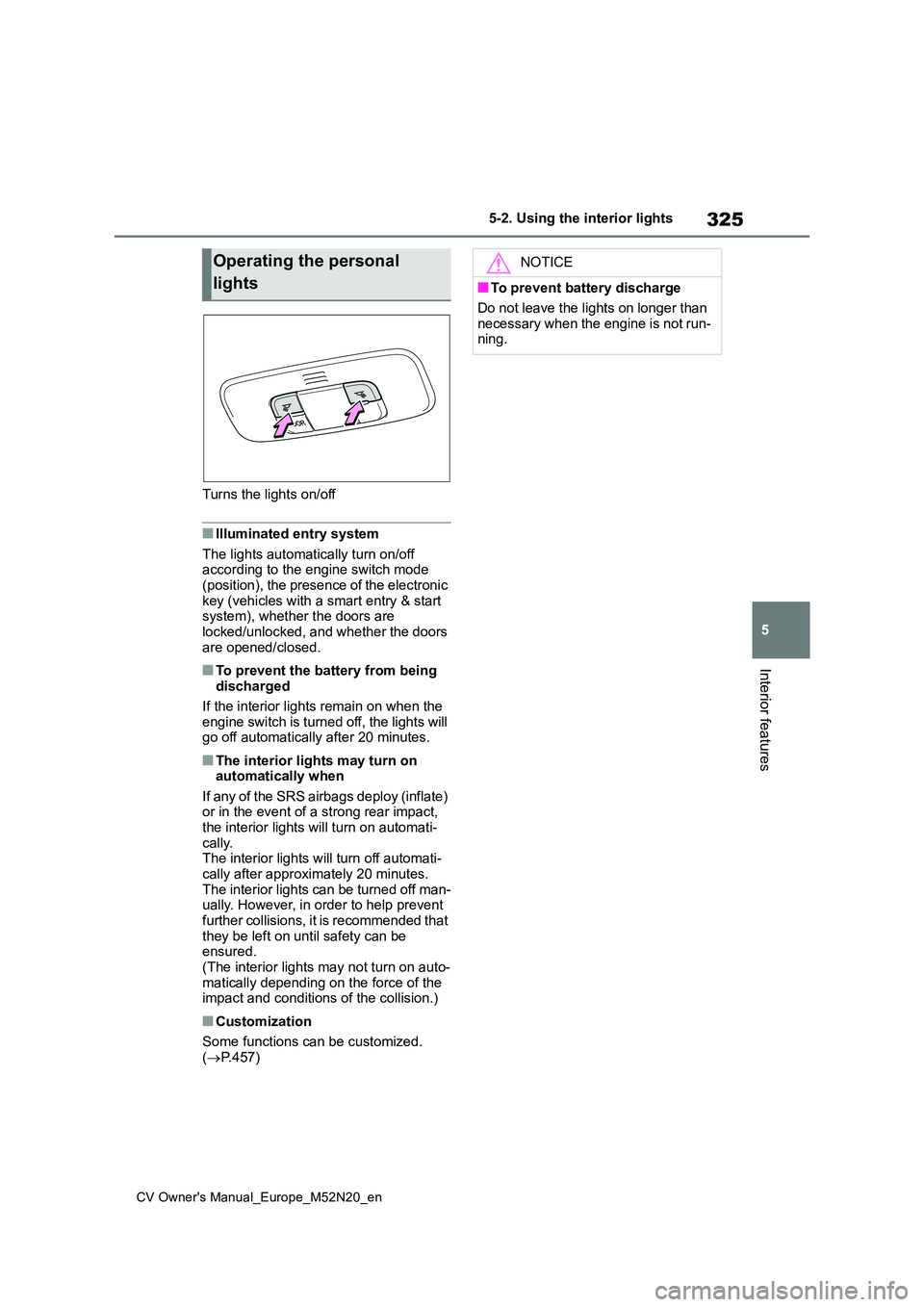
325
5
CV Owner's Manual_Europe_M52N20_en
5-2. Using the interior lights
Interior features
Turns the lights on/off
■Illuminated entry system
The lights automatically turn on/off according to the engine switch mode (position), the presence of the electronic
key (vehicles with a smart entry & start system), whether the doors are locked/unlocked, and whether the doors
are opened/closed.
■To prevent the battery from being discharged
If the interior lights remain on when the
engine switch is turned off, the lights will go off automatically after 20 minutes.
■The interior lights may turn on automatically when
If any of the SRS airbags deploy (inflate) or in the event of a strong rear impact, the interior lights will turn on automati-
cally. The interior lights will turn off automati-cally after approximately 20 minutes.
The interior lights can be turned off man- ually. However, in order to help prevent further collisions, it is recommended that
they be left on until safety can be ensured.(The interior lights may not turn on auto-
matically depending on the force of the impact and conditions of the collision.)
■Customization
Some functions can be customized.
( P.457)
Operating the personal
lights
NOTICE
■To prevent battery discharge
Do not leave the lights on longer than
necessary when the engine is not run- ning.
Page 341 of 618
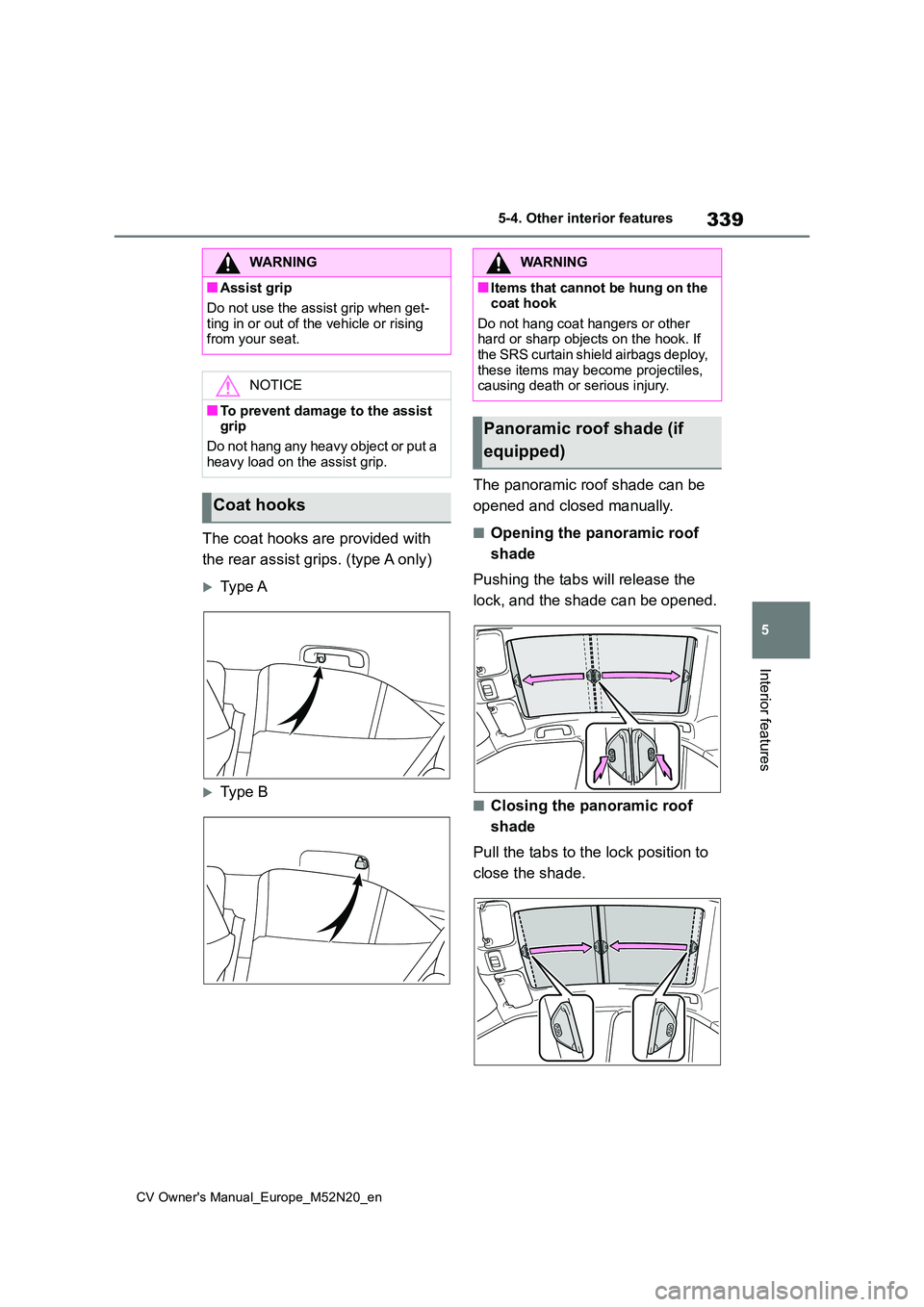
339
5
CV Owner's Manual_Europe_M52N20_en
5-4. Other interior features
Interior features
The coat hooks are provided with
the rear assist grips. (type A only)
Type A
Type B
The panoramic roof shade can be
opened and closed manually.
■Opening the panoramic roof
shade
Pushing the tabs will release the
lock, and the shade can be opened.
■Closing the panoramic roof
shade
Pull the tabs to the lock position to
close the shade.
WARNING
■Assist grip
Do not use the assist grip when get-
ting in or out of the vehicle or rising from your seat.
NOTICE
■To prevent damage to the assist grip
Do not hang any heavy object or put a
heavy load on the assist grip.
Coat hooks
WARNING
■Items that cannot be hung on the coat hook
Do not hang coat hangers or other hard or sharp objects on the hook. If the SRS curtain shield airbags deploy,
these items may become projectiles, causing death or serious injury.
Panoramic roof shade (if
equipped)
Page 347 of 618
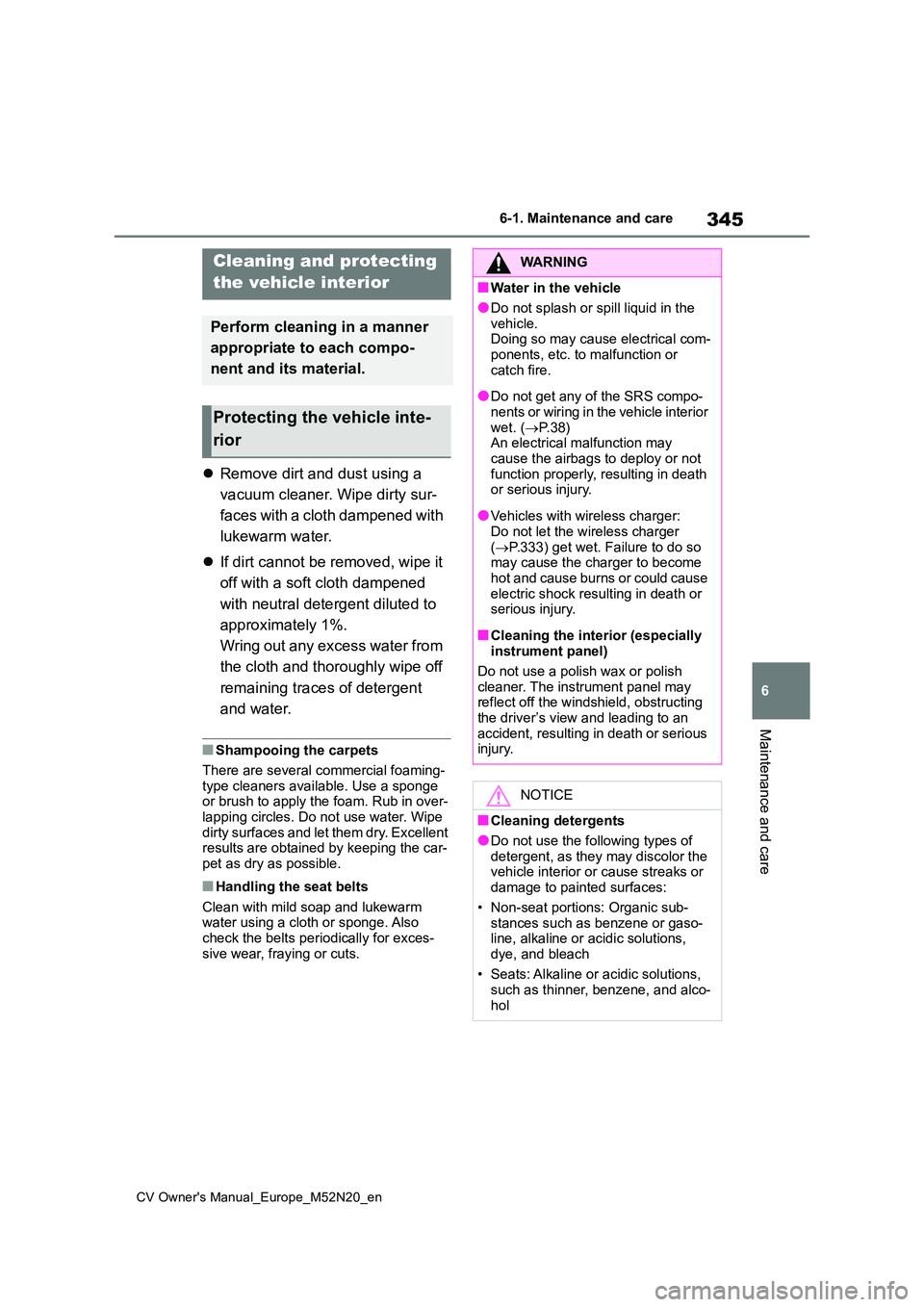
345
6
CV Owner's Manual_Europe_M52N20_en
6-1. Maintenance and care
Maintenance and care
Remove dirt and dust using a
vacuum cleaner. Wipe dirty sur-
faces with a cloth dampened with
lukewarm water.
If dirt cannot be removed, wipe it
off with a soft cloth dampened
with neutral detergent diluted to
approximately 1%.
Wring out any excess water from
the cloth and thoroughly wipe off
remaining traces of detergent
and water.
■Shampooing the carpets
There are several commercial foaming-
type cleaners available. Use a sponge or brush to apply the foam. Rub in over-lapping circles. Do not use water. Wipe
dirty surfaces and let them dry. Excellent results are obtained by keeping the car-pet as dry as possible.
■Handling the seat belts
Clean with mild soap and lukewarm water using a cloth or sponge. Also check the belts periodically for exces-
sive wear, fraying or cuts.
Cleaning and protecting
the vehicle interior
Perform cleaning in a manner
appropriate to each compo-
nent and its material.
Protecting the vehicle inte-
rior
WARNING
■Water in the vehicle
●Do not splash or spill liquid in the
vehicle. Doing so may cause electrical com-ponents, etc. to malfunction or
catch fire.
●Do not get any of the SRS compo-
nents or wiring in the vehicle interior wet. ( P.38) An electrical malfunction may
cause the airbags to deploy or not function properly, resulting in death or serious injury.
●Vehicles with wireless charger:Do not let the wireless charger
( P.333) get wet. Failure to do so may cause the charger to become hot and cause burns or could cause
electric shock resulting in death or serious injury.
■Cleaning the interior (especially instrument panel)
Do not use a polish wax or polish
cleaner. The instrument panel may reflect off the windshield, obstructing the driver’s view and leading to an
accident, resulting in death or serious injury.
NOTICE
■Cleaning detergents
●Do not use the following types of
detergent, as they may discolor the vehicle interior or cause streaks or damage to painted surfaces:
• Non-seat portions: Organic sub- stances such as benzene or gaso-line, alkaline or acidic solutions,
dye, and bleach
• Seats: Alkaline or acidic solutions, such as thinner, benzene, and alco-
hol
Page 396 of 618
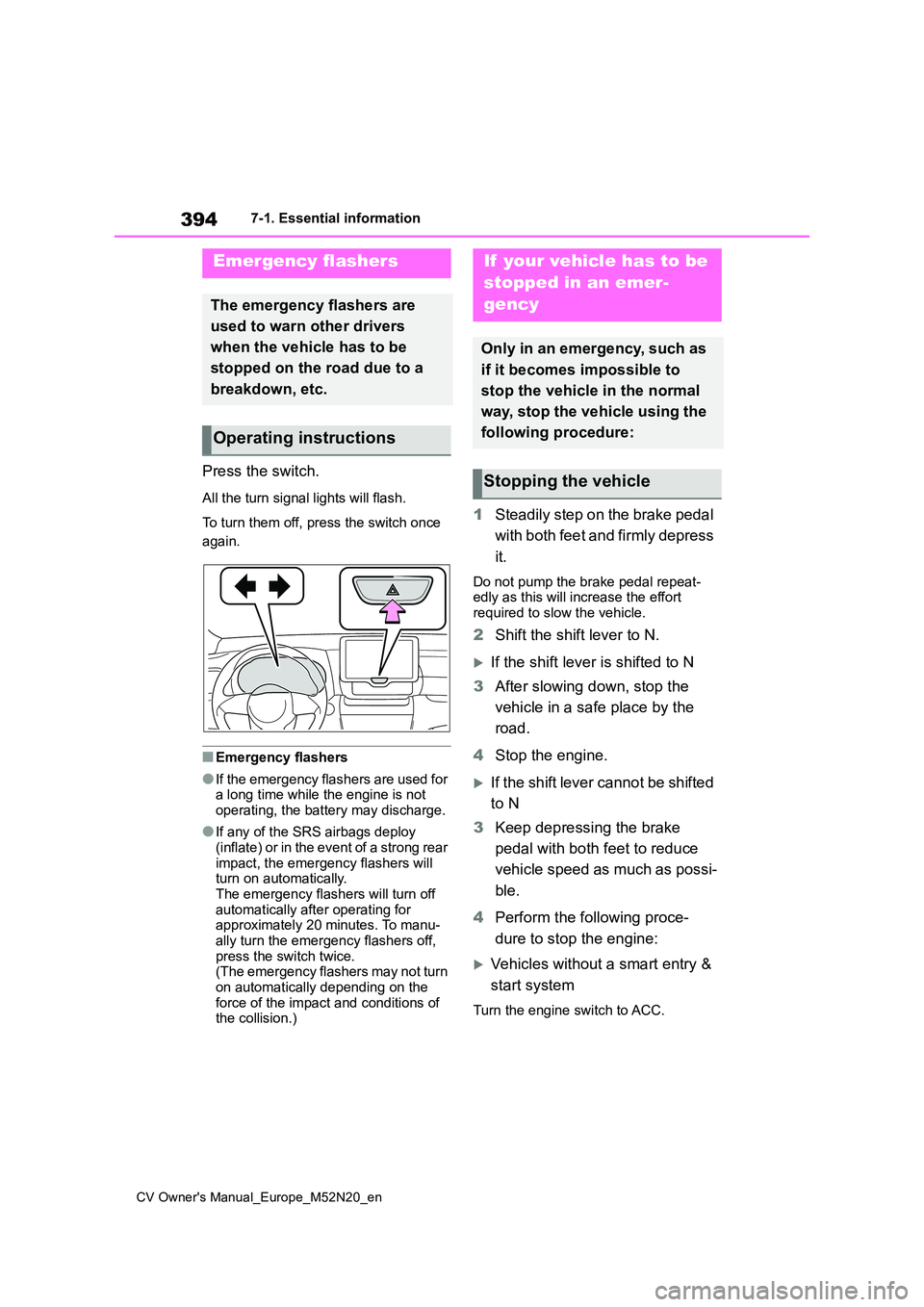
394
CV Owner's Manual_Europe_M52N20_en
7-1. Essential information
7-1.Esse ntial informa tion
Press the switch.
All the turn signal lights will flash.
To turn them off, press the switch once
again.
■Emergency flashers
●If the emergency flashers are used for a long time while the engine is not
operating, the battery may discharge.
●If any of the SRS airbags deploy
(inflate) or in the event of a strong rear impact, the emergency flashers will turn on automatically.
The emergency flashers will turn off automatically after operating for approximately 20 minutes. To manu-
ally turn the emergency flashers off, press the switch twice.(The emergency flashers may not turn
on automatically depending on the force of the impact and conditions of the collision.)
1 Steadily step on the brake pedal
with both feet and firmly depress
it.
Do not pump the brake pedal repeat- edly as this will increase the effort required to slow the vehicle.
2 Shift the shift lever to N.
If the shift lever is shifted to N
3 After slowing down, stop the
vehicle in a safe place by the
road.
4 Stop the engine.
If the shift lever cannot be shifted
to N
3 Keep depressing the brake
pedal with both feet to reduce
vehicle speed as much as possi-
ble.
4 Perform the following proce-
dure to stop the engine:
Vehicles without a smart entry &
start system
Turn the engine switch to ACC.
Emergency flashers
The emergency flashers are
used to warn other drivers
when the vehicle has to be
stopped on the road due to a
breakdown, etc.
Operating instructions
If your vehicle has to be
stopped in an emer-
gency
Only in an emergency, such as
if it becomes impossible to
stop the vehicle in the normal
way, stop the vehicle using the
following procedure:
Stopping the vehicle
Page 404 of 618
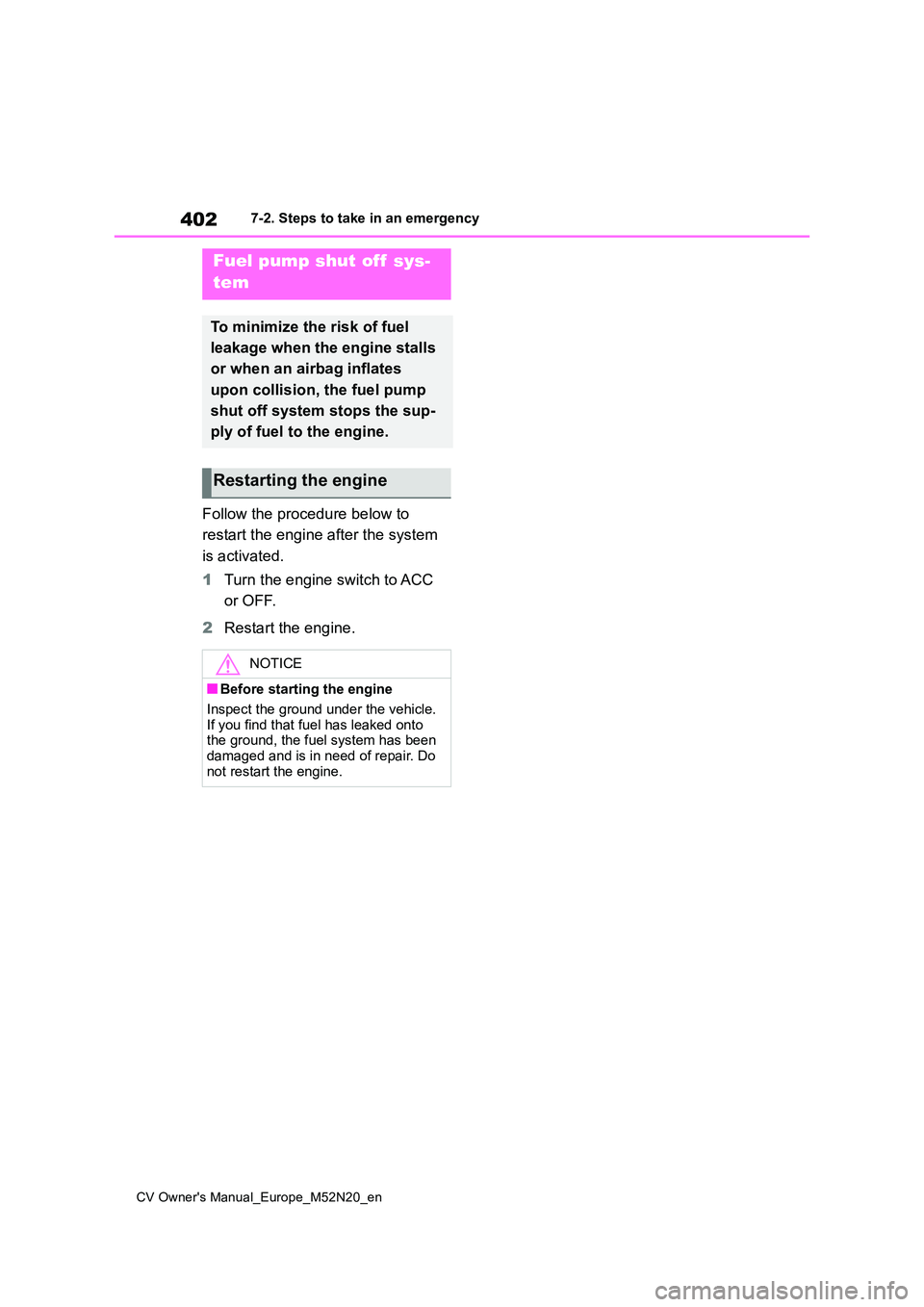
402
CV Owner's Manual_Europe_M52N20_en
7-2. Steps to take in an emergency
Follow the procedure below to
restart the engine after the system
is activated.
1 Turn the engine switch to ACC
or OFF.
2 Restart the engine.
Fuel pump shut off sys-
tem
To minimize the risk of fuel
leakage when the engine stalls
or when an airbag inflates
upon collision, the fuel pump
shut off system stops the sup-
ply of fuel to the engine.
Restarting the engine
NOTICE
■Before starting the engine
Inspect the ground under the vehicle. If you find that fuel has leaked onto the ground, the fuel system has been
damaged and is in need of repair. Do not restart the engine.
Page 406 of 618

404
CV Owner's Manual_Europe_M52N20_en
7-2. Steps to take in an emergency
■Charging system warning light*
*: This light illuminates on the multi-information display.
■Low engine oil pressure warning light* (warning buzzer)
*: This light illuminates on the multi-information display.
■Malfunction indicator lamp* (warning buzzer)
*: This light illuminates on the multi-information display (with 7-inch display only).
■SRS warning light (warning buzzer)
Warning lightDetails/Actions
Indicates a malfunction in the vehicle’s charging system
Immediately stop the vehicle in a safe place and contact
any authorized Toyota retailer or Toyota authorized
repairer, or any reliable repairer.
Warning lightDetails/Actions
Indicates that the engine oil pressure is excessively low
Immediately stop the vehicle in a safe place and contact
any authorized Toyota retailer or Toyota authorized
repairer, or any reliable repairer.
Warning lightDetails/Actions
Indicates a malfunction in:
The electronic engine control system;
The electronic throttle control system; or
The electronic Multidrive (if equipped) control system
Immediately stop the vehicle in a safe place and contact
any authorized Toyota retailer or Toyota authorized
repairer, or any reliable repairer.
Warning lightDetails/Actions
Indicates a malfunction in:
The SRS airbag system; or
The seat belt pretensioner system
Have the vehicle inspected by any authorized Toyota
retailer or Toyota authorized repairer, or any reliable
repairer immediately.
Page 427 of 618
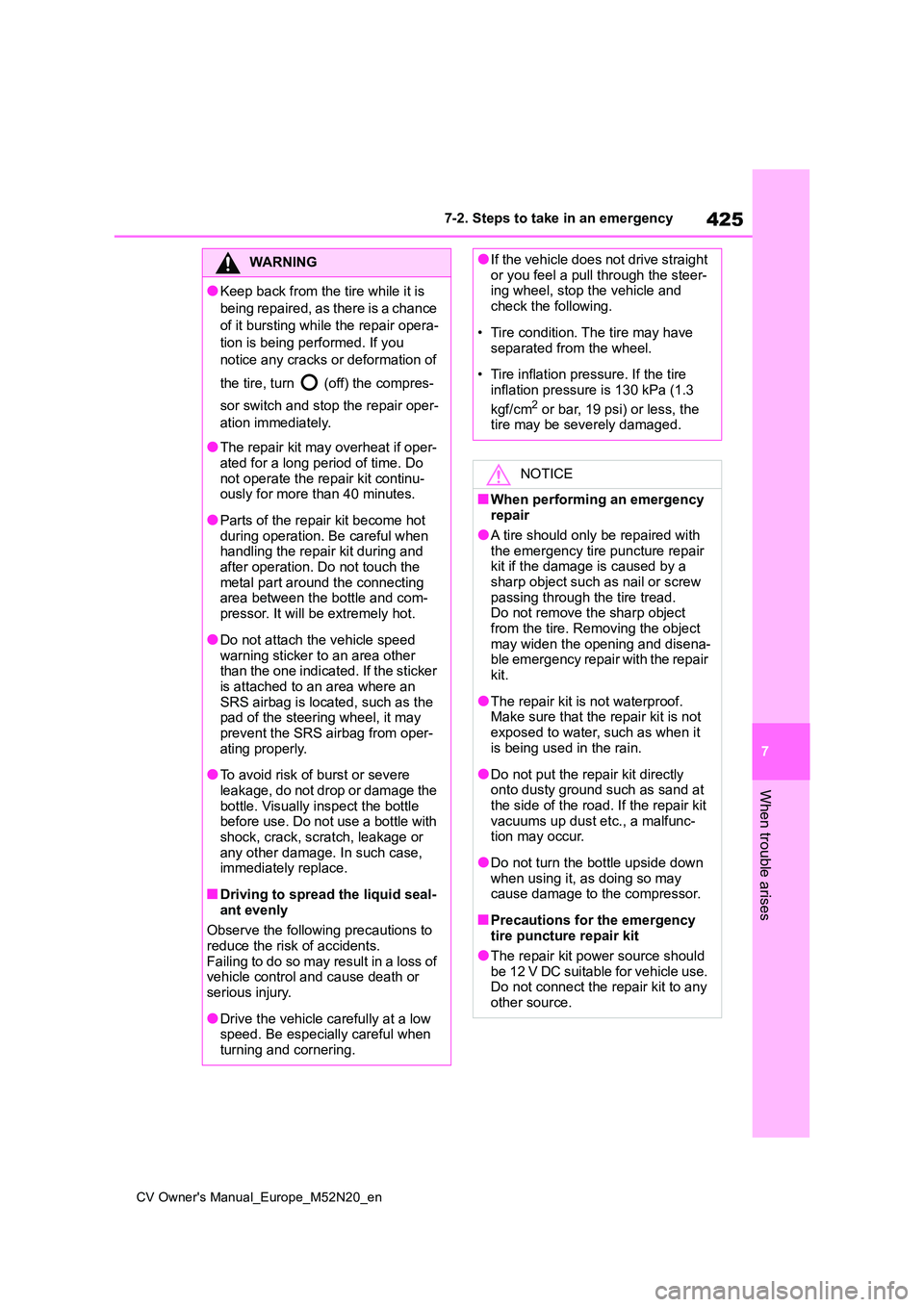
425
7
CV Owner's Manual_Europe_M52N20_en
7-2. Steps to take in an emergency
When trouble arises
WARNING
●Keep back from the tire while it is
being repaired, as there is a chance
of it bursting while the repair opera-
tion is being performed. If you
notice any cracks or deformation of
the tire, turn (off) the compres-
sor switch and stop the repair oper-
ation immediately.
●The repair kit may overheat if oper- ated for a long period of time. Do
not operate the repair kit continu- ously for more than 40 minutes.
●Parts of the repair kit become hot during operation. Be careful when handling the repair kit during and
after operation. Do not touch the metal part around the connecting area between the bottle and com-
pressor. It will be extremely hot.
●Do not attach the vehicle speed
warning sticker to an area other than the one indicated. If the sticker is attached to an area where an
SRS airbag is located, such as the pad of the steering wheel, it may prevent the SRS airbag from oper-
ating properly.
●To avoid risk of burst or severe
leakage, do not drop or damage the bottle. Visually inspect the bottle before use. Do not use a bottle with
shock, crack, scratch, leakage or any other damage. In such case, immediately replace.
■Driving to spread the liquid seal-
ant evenly
Observe the following precautions to reduce the risk of accidents.
Failing to do so may result in a loss of vehicle control and cause death or serious injury.
●Drive the vehicle carefully at a low speed. Be especially careful when
turning and cornering.
●If the vehicle does not drive straight or you feel a pull through the steer-ing wheel, stop the vehicle and
check the following.
• Tire condition. The tire may have
separated from the wheel.
• Tire inflation pressure. If the tire
inflation pressure is 130 kPa (1.3
kgf/cm2 or bar, 19 psi) or less, the tire may be severely damaged.
NOTICE
■When performing an emergency repair
●A tire should only be repaired with
the emergency tire puncture repair kit if the damage is caused by a sharp object such as nail or screw
passing through the tire tread. Do not remove the sharp object from the tire. Removing the object
may widen the opening and disena- ble emergency repair with the repair kit.
●The repair kit is not waterproof. Make sure that the repair kit is not
exposed to water, such as when it is being used in the rain.
●Do not put the repair kit directly onto dusty ground such as sand at the side of the road. If the repair kit
vacuums up dust etc., a malfunc- tion may occur.
●Do not turn the bottle upside down when using it, as doing so may cause damage to the compressor.
■Precautions for the emergency tire puncture repair kit
●The repair kit power source should be 12 V DC suitable for vehicle use. Do not connect the repair kit to any
other source.
Page 475 of 618

473
CV Owner's Manual_Europe_M52N20_en
Alphabetical Index
Alphabetical Index
A
A/C
Air conditioning filter................... 376
Automatic air conditioning system
................................................. 316
Manual air conditioning system.. 312
ABS (Anti-lock Brake System) .... 301
Warning light .............................. 405
ACA (Active Cornering Assist) .... 301
Active Cornering Assist (ACA) .... 301
Adaptive High-beam System ....... 197
AHB (Automatic High Beam) ....... 201
AHS (Adaptive High-beam System)
..................................................... 197
Air conditioning filter ................... 376
Air conditioning system
Air conditioning filter................... 376
Automatic air conditioning system
................................................. 316
Manual air conditioning system.. 312
Airbag manual on-off system ........ 47
Airbags ............................................ 38
Airbag manual on-off system ....... 47
Airbag operating conditions ......... 40
Airbag precautions for your child . 43
Correct driving posture................. 33
Curtain shield airbag operating con-
ditions ........................................ 40
Curtain shield airbag precautions 43
General airbag precautions.......... 43
Locations of airbags ..................... 38
Modification and disposal of airbags
................................................... 45
Side airbag operating conditions.. 40
Side airbag precautions ............... 43
Side and curtain shield airbags oper-
ating conditions.......................... 40
Side and curtain shield airbags pre-
cautions ..................................... 43
SRS airbags ................................. 38
SRS warning light.......................404
Alarm................................................77
Alarm ............................................ 77
Warning buzzer .......................... 403
Antennas (smart entry & start sys-
tem) ..............................................136
Anti-lock Brake System (ABS)..... 301
Warning light .............................. 405
Approach warning ................ 245, 256
Assist grips ...................................338
Audio remote control switches ... 338
Audio system-linked display .97, 103
Automatic air conditioning system
..................................................... 316
Automatic headlight leveling system
..................................................... 193
Automatic High Beam ..................201
Automatic light control system ... 193
Auxiliary box ................................. 329
Average fuel economy ...........96, 101
Average vehicle speed ...........98, 103
B
Back door ...................................... 123
Hands Free Power Back Door ... 128
Power back door ........................ 126
Wireless remote control ............. 126
Back-up light
Replacing light bulbs ..........387, 390
Battery ........................................... 358
Battery checking......................... 358
If the battery is discharged ......... 439
Installing the battery ........... 360, 361
Preparing and checking before win-
ter ............................................. 307
Removing the battery ......... 359, 360
Warning light .............................. 404